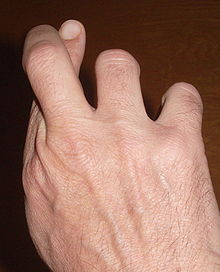Truce term
Examples of use of truce terms are if a child has a stitch or wants to raise a point on the rules of the game.
Traditionally these terms are specific to certain geographical areas, although some may be used by a particular social group such as pax in the UK (used primarily by children attending private schools).
The use of a truce term is usually accompanied by a gesture, such as crossed fingers of one or both hands or the raising of thumbs.
Truce terms are recorded as having been used in the following circumstances; being out of breath, having a stitch, a shoelace being undone, fear of clothes being damaged, needing to go to the lavatory, checking the time, wanting to discuss or clarify rules during a fight or game, or one combatant wanting to remove their spectacles or jacket before continuing.
[6] The vocabulary of children's games, including truce terms, is described by sociolinguist Peter Trudgill in Dialects of England as being particularly rich in regional variation insofar as it is not based on official or television culture.
[8] The Opies conducted a study of the use of truce terms throughout England, Scotland and Wales in the 1950s and published their results in a book called The Lore and Language of Schoolchildren.
The use of barlay as a truce term appears in the 14th century poem Sir Gawayne and the Grene Knight and Tobias Smollett's The Reprisal.
It is recorded in lexicographer John Jamieson's 1808 Etymological Dictionary of the Scottish Language as a term specifically used by children to demand truce.
A probable variation also appears in the 1568 manuscript Chrysts-Kirk of the Grene, sometimes attributed to James I of Scotland, as follows; The "Thoume" (thumb) that is "sklyss" (sliced) in the quote above may refer to the thumb having been raised by the man calling barlafummill, a common accompanying gesture to the use of a truce term in Scotland.
[2] Fainites and fains (or vainites and vains) predominated in London and throughout southern England, apart from the scribs and screams of east Hampshire, and extended north as far as Olney in Buckinghamshire.
[2] Another translation of the Anglo-Norman word feindre is "pretend, feign, turn a blind eye to", which is what the more powerful child does whilst granting respite.
[5] Spoken English south of the Danelaw became, from at least the 11th century onwards, characterised by a pronunciation known as Southern Voicing, such as vrog for frog, or zummer for summer.
Vainites or vains, variants of fainites or fains, are surviving examples of this on the borders of the Danelaw to the north of London.
[2] Kings truce is found in Thomas Dekker's The Honest Whore, Part One (II,i), which appeared in 1604.
Skinch or skinge predominated in Northumberland and Durham, another term first recorded in a nineteenth-century dialect dictionary.
[2] Keys was found by the Opies to be the prevailing term in western Scotland and in a strip running through north-west England in an otherwise predominantly barley area.
[2] Many individual cities, towns and rural districts had their own words, not used elsewhere such as bees, blobs, croggies, denny, keppies, locks, peas, peril, nix, truce, snakes and twigs.
The authors concluded that either the Opies had grossly oversimplified the picture or things had radically changed in 30 years (some seven to eight generations of primary school children).
[13][14][15] A study undertaken between 1999 and 2001 in New Zealand by lexicographers Laurie and Winifred Bauer on traditional forms of play included truce terms.
The terms they described in their study were regional and the most common were pegs (widespread), twigs (Taranaki), gates (Auckland), tags (Nelson Marlborough), and nibs (Otago-Southland).
Apparently unrecorded before World War II this appears to have first changed to pags, probably from being shouted out at length, and then further mutated by virtue of broad New Zealand accents to pegs.
[9] The Dictionary of American Regional English cites the Opies as a source for the derivation of the terms and states that exes probably refers to the use of crossed fingers, an important part of the demand for a truce, rather than deriving from "excuse" as originally thought.
[17] The Knapps study in Monroe County, Indiana, found time-out and times to be by far the most prevalent terms in the 1970s.
The few alternatives included pax, safe, base or home-base and freeze with one small area of fins (Mount Vernon).
Other gestures, reported in ones and twos, included miming an injection into the arm, licking the thumb, making a T-shape with the hands, three fingers held up and the "Vulcan" sign from Star Trek.
[4] The holding up of one hand with middle and index fingers crossed was the usual gesture found in New Zealand in 1999–2001.


